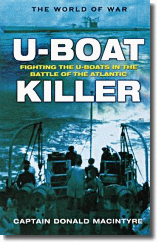|
|
|||||
 U-Boat
Killer U-Boat
KillerAuthor: Capt. Donald MacIntyre Publisher: Cassell Military Classics (paperback); Rigel Publications (hardback) First published: 1956 Reviewer: John Hopkin Having more than a mild interest in WWII submarine naval history, beside me is a shelf full of the usual books, from Das Boot to dry technical references such as Robert C Stern’s dissection of Type VII U-boats and Clay Blair’s major volumes on the Battle of the Atlantic. Glancing along the spines, only one of those books makes me smile and chuckle to myself, and that is Donald MacIntyre’s excellent memoir. Perhaps being the proud owner of an original 1956 first edition, signed by the author (upon which this review is based), has something to do with it, but I don’t think so. It’s simply a superb read. A British destroyer captain from the beginning of the war almost to its end, captaining the destroyers Walker and Hesperus and the smaller Bickerton, as well as leading the famous Group 5 anti-submarine group, McIntyre established himself as one of the greats. He captured the number one German U-boat ace Otto Kretschmer (whose Zeiss binoculars he took and used for the rest of the war); in the same battle, he directed the attack that killed the second-scoring ace Joachim Schepke. Later in the war, his ship was torpedoed; before that he nursed a bent-nosed destroyer back to port after ramming a U-boat. To say that he’d seen it all, and acted throughout with skill and acumen, would be understatement. And yet the tone of his memoir is exactly that. With clarity, a sparkling wit and a disarming amount of modesty, MacIntyre takes us through his days in command of destroyers and anti-submarine groups in the North Atlantic from 1939 to late 1944. Aside from a brief land-based respite at the escort base in Argentia, he was at sea almost all of the time, guarding convoys and, later, commanding “Hunter/Killer” groups – all the while, searching for the elusive U-boats that were his prey. Hunting them, and simultaneously fearing them, he acquitted himself extraordinarily well, becoming a legend among ASW seamen and their submerged foes alike. Sometimes we have to reflect a little to realise what an earnest, tough and skilled man he was – the book is liberally peppered with anecdote, dry humour, and plain suspense. Sometimes, the book reads like an exciting war novel, and at others like a series of very funny stories. Throughout, his modesty is astounding – if you took him at his word, you’d think that every one of his successes was due to the skills and efforts of those around him, or simply to luck. He is not given to self-congratulation. Nor does he skimp on the technical details, although these are presented in a manner that assumes little prior knowledge on the part of the reader. If you want to know how radio direction finding worked, for example, or the practical limitations of sonar, or convoy defence tactics, or the mechanics of refuelling a destroyer at sea, you’ll find it explained plainly here, and in a useful and informative manner, whether or not you already know the basics. Even an experienced war historian is likely to learn new nuggets from old Captain McIntyre. Because of the chronological structure of the book, and its reliance on suspense and finely-tuned doubt, I’m loathe to give away much about what actually happens, but it would be a disservice to the author not to quote a couple of passages to give a flavour of the general humour, warmth and detail which gives this book its primary character. After a near-breakdown caused by the stress of protecting early-war convoys, was assigned to a desk-job in Argentia. He recalls his time there with fondness, and he developed an admiration for the resources and sheer hard work of the resident Americans. As the base was being built in haste around him, he recalls: “Roads were laid down with the speed of an unrolling carpet and as often as not vanished again equally quickly when their purpose had been achieved. I well remember being bidden to dinner in the Admiral’s mess one night and finding, when I wished to return to my own quarters, that the road by which I had come had vanished like a dream. As the ‘Flag Mess’ was ‘dry’ in accordance with US naval custom, I needed a very strong restorative to recover from the shock when I got home.” Soon enough, he was fed up with shore life, and, now recovered, returned to sea in his previous capacity. Later, he recalls the practical problems of launching depth-charges from a destroyer in high seas:
I don’t know about you, but that makes me glad to have central heating and warm, dry socks when I read it – and it’s characteristic of the hardships he and his crews had to overcome, and which they accepted as part of their life. One can’t help feeling gratitude towards those unsung, drenched loaders after reading that paragraph. The narrative, novel-like structure works very well throughout, keeping up suspense and making the reader turn pages quicker than perhaps we should. A particularly gripping sequence describes Hesperus’ attack on U-223 from both sides of the encounter. MacIntyre weaves together his own ship’s account with the U-boat’s and produces an account that is suspenseful and extremely unusual. Without revealing the outcome, I can say that this is one of the most surprising of the many descriptions of such combat, in several different ways. McIntyre describes the events adroitly as they unfold, and clearly shares our astounded reaction to the outcome. The final chapter, “The Future”, an near-epilogue which discusses the continuing role of convoy escorts from a mid-1950s perspective, is intriguing in itself. He is obviously concerned about the lack of such provisions in the contemporary Royal Navy and US Navy, but the details of nuclear submarines, helicopters, and similar technologies were only just emerging. Completely outdated in the 21st Century, his musings are interesting for their almost immediately post-war context. So far, I’ve only had praise for this book. “What,” I can hear you ask,“ is less than superb about it?” Well, some people might possibly find the language a little out-of-date, or perhaps too “British”. The quotes above give a good flavour of his style, if that’s a worry. Compared to most writers of his generation, his prose strikes me as very clear and uncluttered, while still conveying with accuracy and depth the astounding life he lived at sea. I recommend this book without any particular reservation. Not many books I’ve read deserve that, but, as I said, this is an eternal favourite. It was a delight to re-read it for this review, and the next time I glance at the row of spines on the shelf and see MacIntyre’s name, I’ll hope that my wide grin of appreciation will be echoed on the faces of other, newer readers of this fascinating and enjoyable memoir. And maybe we’ll pluck the book from the shelf yet again and say “thanks” to Captain McIntyre as we settle down to read about the dangers and tribulations he and his men suffered for us.
|

